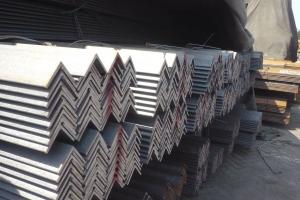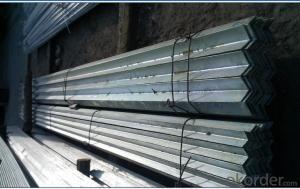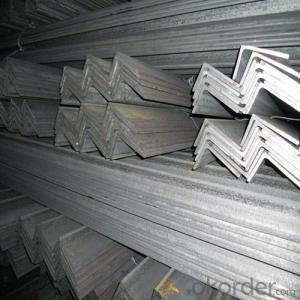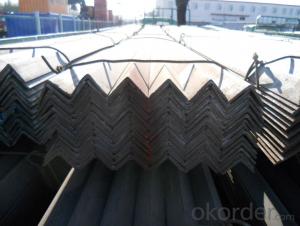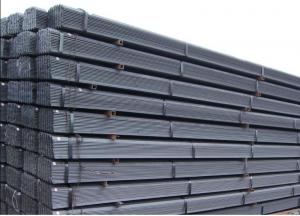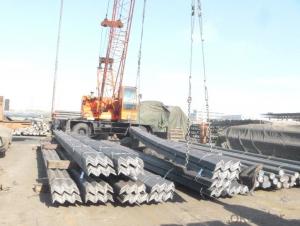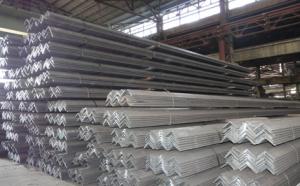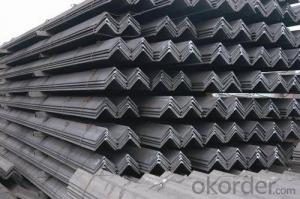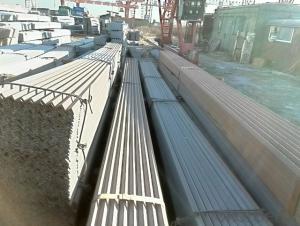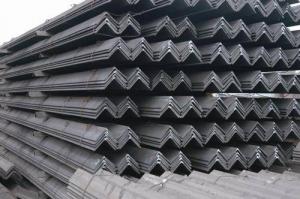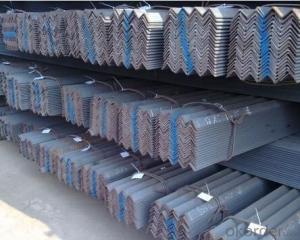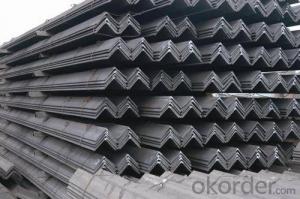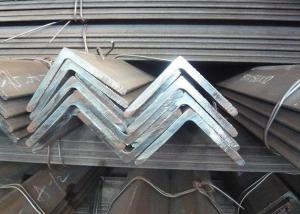Hot Rolled Angle steel;steel angle
- Loading Port:
- Tianjin
- Payment Terms:
- TT OR LC
- Min Order Qty:
- 2000 m.t.
- Supply Capability:
- 10000 m.t./month
OKorder Service Pledge
OKorder Financial Service
You Might Also Like
Product Description:
Specifications of Hot Rolled Angle Steel
1.Standards:GB,ASTM,BS,AISI,DIN,JIS
2. Invoicing on theoretical weight or actual weight as customer request3.Material:GBQ235B,Q345BorEquivalent;ASTMA36;EN10025,S235JR,S355JR;JISG3192,SS400;SS540.
4. Payment terms:
1).100% irrevocable L/C at sight.
2).30% T/T prepaid and the balance against the copy of B/L.
3).30% T/T prepaid and the balance against L/C
5.Sizes:
EQUAL ANGLES SIZES | |||
a(mm) | a1(mm) | thickness(mm) | length |
25 | 25 | 2.5---3.0 | 6M/12M |
30 | 30 | 2.5---4.0 | 6M/12M |
38 | 38 | 2.5 | 6M/12M |
38 | 38 | 3.0---5.0 | 6M/12M |
40 | 40 | 3.0---6.0 | 6M/12M |
50 | 50 | 3 | 6M/12M |
50 | 50 | 3.7---6.0 | 6M/9M/12M |
60 | 60 | 5.0---6.0 | 6M/9M/12M |
63 | 63 | 6.0---8.0 | 6M/9M/12M |
65 | 65 | 5.0---8.0 | 6M/9M/12M |
70 | 70 | 6.0---7.0 | 6M/9M/12M |
75 | 75 | 5.0---10.0 | 6M/9M/12M |
80 | 80 | 6.0---10.0 | 6M/9M/12M |
90 | 90 | 6.0---10.0 | 6M/9M/12M |
100 | 100 | 6.0---12.0 | 6M/9M/12M |
120 | 120 | 8.0-12.0 | 6M/9M/12M |
125 | 125 | 8.0---12.0 | 6M/9M/12M |
130 | 130 | 9.0-12.0 | 6M/9M/12M |
140 | 140 | 10.0-16.0 | 6M/9M/12M |
150 | 150 | 10---15 | 6M/9M/12M |
160 | 160 | 10---16 | 6M/9M/12M |
180 | 180 | 12---18 | 6M/9M/12M |
200 | 200 | 14---20 | 6M/9M/12M |
Usage & Applications Hot Rolled Angle Steel
According to the needs of different structures, Angle can compose to different force support component, and also can be the connections between components. It is widely used in various building structures and engineering structures such as roof beams, bridges, transmission towers, hoisting machinery and transport machinery, ships, industrial furnaces, reaction tower, container frame and warehouse etc.
- Q: What are the different grades of steel used for angles?
- The different grades of steel commonly used for angles include A36, A572, and A588.
- Q: What is the difference between the main keel and the angle steel and the channel steel?
- The boat in the boat, the boat is keel or load-bearing structure is the most important. It's at the bottom of the ship. On the keel, there is reinforcement across the ship's ribs. The bow and stern keel off the bow post. The keel is usually the first one to be part of the hull construction. The keel laying is the most important event in the shipbuilding process.
- Q: Can steel angles be used in framing?
- Yes, steel angles can be used in framing. Steel angles are commonly used in construction for structural support and reinforcement. They are versatile and can be easily welded, bolted, or screwed together to create frames for various applications. Steel angles provide strength and stability to the structure and can be used in framing walls, ceilings, floors, and other structural components. Additionally, steel angles are available in different sizes and thicknesses, allowing for flexibility in design and construction. Overall, steel angles are a popular choice in framing due to their durability, versatility, and structural properties.
- Q: Can steel angles be used in electrical or telecommunications installations?
- Yes, steel angles can be used in electrical or telecommunications installations. Steel angles are commonly used as structural supports and mounting brackets in these types of installations due to their strength, durability, and versatility.
- Q: Can steel angles be used for electrical conduits?
- Steel angles cannot serve as electrical conduits. Electrical conduits are commonly made from non-metallic materials like PVC or metal materials such as galvanized steel or aluminum. Steel angles, on the other hand, are utilized for structural support and reinforcement in construction endeavors, but they are not intended or appropriate for use as electrical conduits. Electrical conduits have specific insulation, protection, and grounding requirements that steel angles do not fulfill. To ensure the integrity and efficiency of electrical installations, it is crucial to employ appropriate electrical conduits that satisfy the necessary safety standards.
- Q: Can steel angles be used for stair treads?
- Stair treads can indeed utilize steel angles. Known as angle irons as well, steel angles find frequent application in construction and fabrication due to their robustness and resilience. Acting as stair treads, steel angles furnish a firm base for individuals to ascend or descend the stairs. The inclined form of these steel angles enables superior weight allocation and heightened stability. Furthermore, steel angles can be effortlessly welded or bolted to the stair stringers or supports, rendering them a convenient and dependable selection for stair treads.
- Q: Can steel angles be used in conveyor systems?
- Conveyor systems can indeed utilize steel angles. These angles are frequently employed in conveyor systems to provide stability and structural support. They can be employed to establish the framework for the conveyor system, encompassing the conveyor bed, side frames, and supports. Steel angles are renowned for their durability and strength, making them an optimal choice for handling hefty loads and enduring the continual movement and impact encountered by conveyor systems. Furthermore, steel angles can be easily joined through welding or bolting, enabling flexibility in designing and customizing conveyor systems to meet specific requirements. In summary, steel angles are a sought-after option in conveyor system construction due to their dependability, adaptability, and cost-effectiveness.
- Q: What are steel angles used for?
- Steel angles are commonly used in construction and manufacturing industries for a variety of purposes. One of the main uses of steel angles is in structural applications. They are often used as supports, braces, and reinforcements in buildings, bridges, and other infrastructure projects. The L-shape of the angle provides added strength and stability, making it an ideal choice for constructing load-bearing structures. Steel angles are also used in the manufacturing industry for fabricating various products. They can be welded, drilled, and cut to create custom shapes and structures. They are commonly used as frames, brackets, and supports for machinery, equipment, and vehicles. Additionally, steel angles are used in the fabrication of furniture, shelves, racks, and other storage solutions. Their sturdy construction makes them suitable for supporting heavy loads, making them ideal for applications in warehouses, garages, and factories. In summary, steel angles are versatile and widely used in construction and manufacturing industries for their strength, stability, and adaptability. From supporting structures to fabricating products, they play a crucial role in various applications.
- Q: Which is cheaper, angle iron or steel pipe?
- Steel pipe is not only used to transport fluid and powder solid, exchange heat energy, and manufacture mechanical parts and containers, but also is an economic steel. It can reduce weight and save 20 to 40% of metal by using steel pipe to make building structure, network frame, prop and mechanical support. Moreover, it can realize factory mechanization construction. Using steel pipe to manufacture road bridge can not only save steel, simplify construction, but also greatly reduce the area of coating protective layer, save investment and maintenance cost.
- Q: Can steel angles be used in fencing?
- Yes, steel angles can be used in fencing. Steel angles are commonly used in fencing applications to provide structural support and stability. They can be used as posts or crossbars, depending on the specific fencing design. Steel angles are strong and durable, making them suitable for withstanding the elements and providing security. They can be easily welded or bolted together to create a sturdy fencing structure. Additionally, steel angles can be galvanized or coated to enhance their resistance to rust and corrosion, ensuring a long-lasting and low-maintenance fencing solution.
Send your message to us
Hot Rolled Angle steel;steel angle
- Loading Port:
- Tianjin
- Payment Terms:
- TT OR LC
- Min Order Qty:
- 2000 m.t.
- Supply Capability:
- 10000 m.t./month
OKorder Service Pledge
OKorder Financial Service
Similar products
Hot products
Hot Searches
Related keywords
